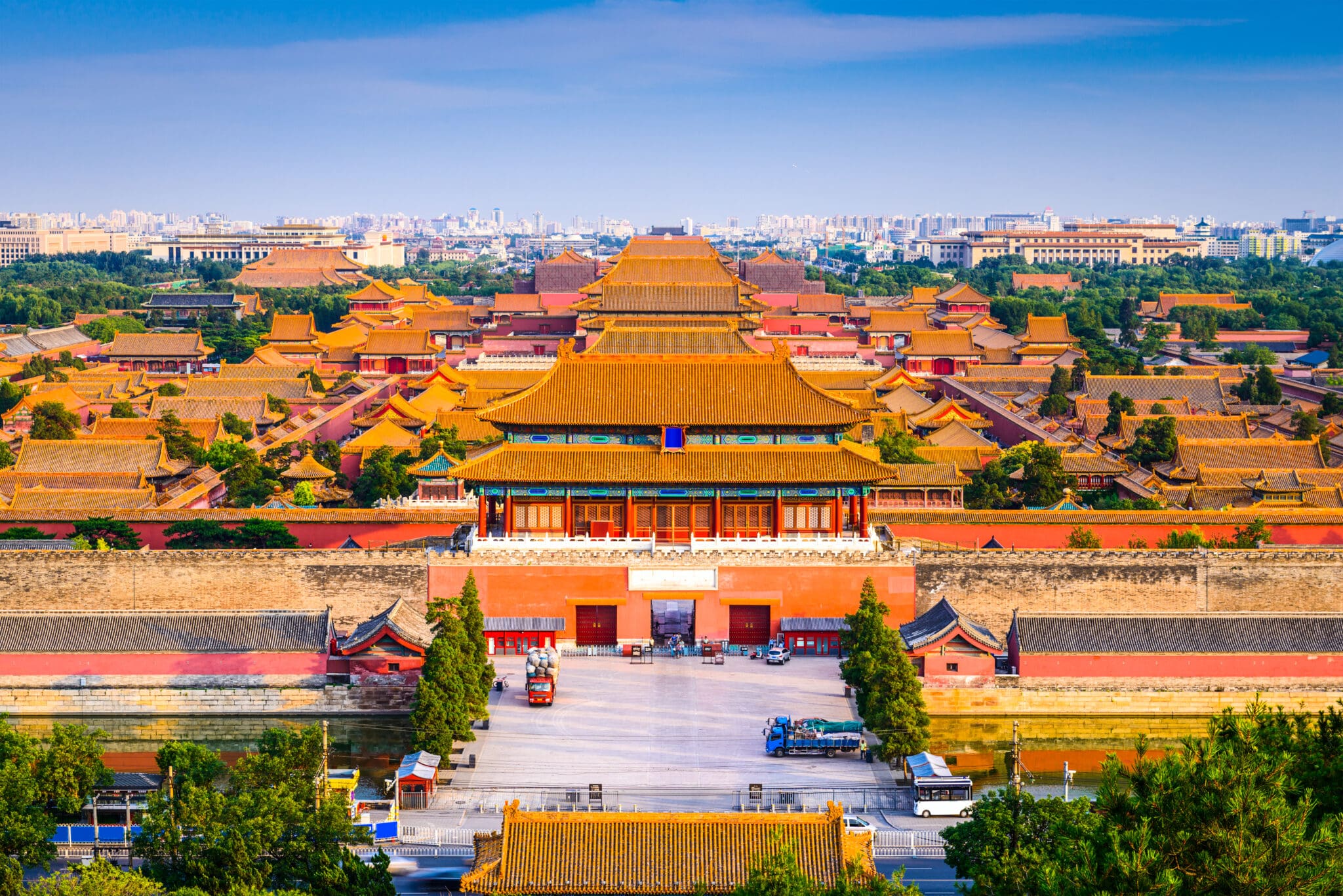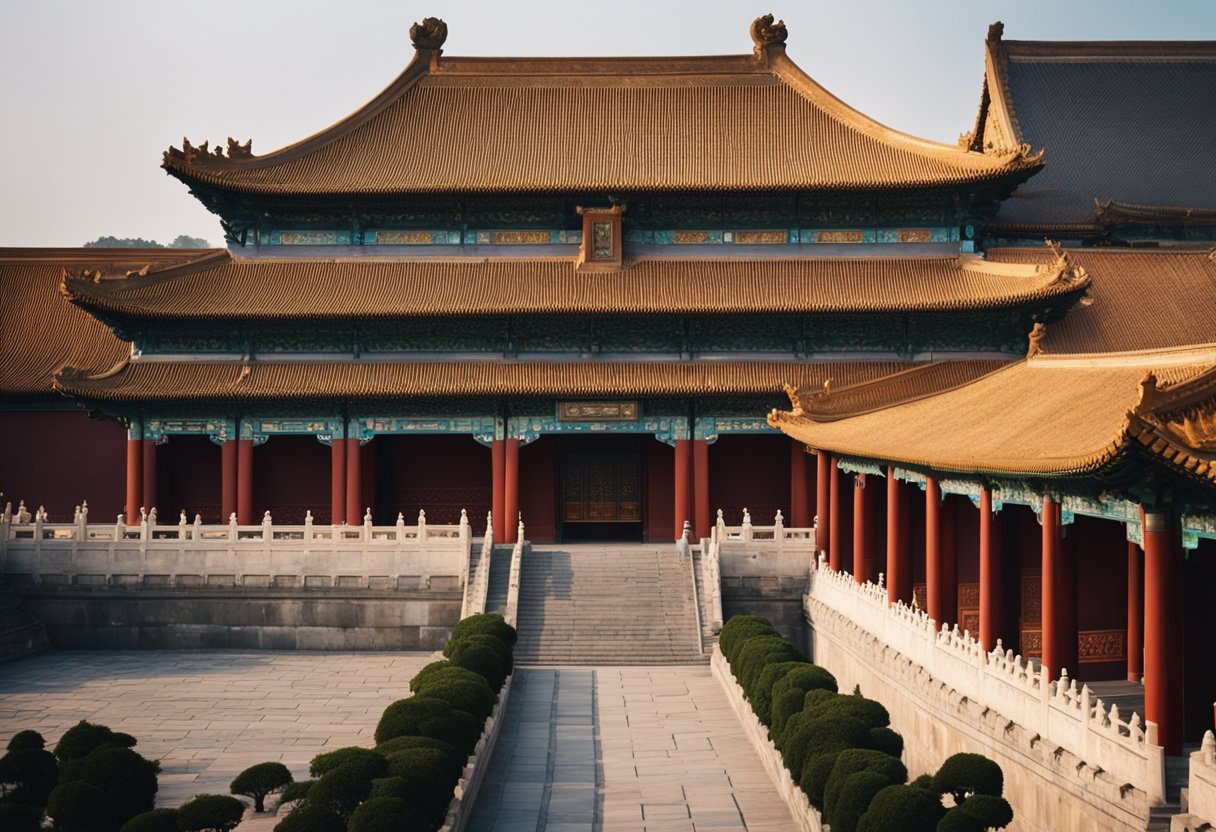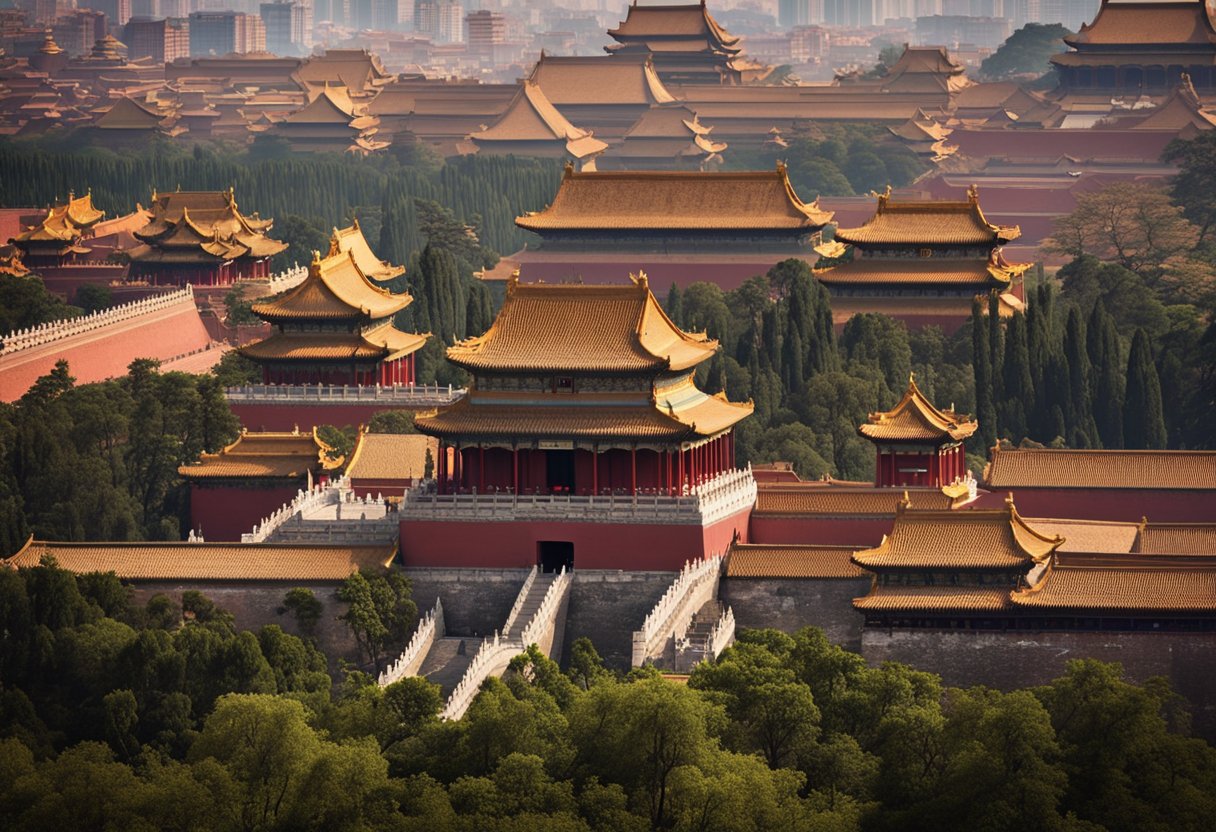China’s Forbidden City: Unveiling the Mysteries of Earth’s Vastest Imperial Enclosure

Updated On: March 11, 2024 by Noha Basiouny
Tucked away in the heart of Beijing, China’s Forbidden City stands as a monumental tribute to the grandeur of the country’s imperialism. Sprawling over 720,000 square metres, this palace complex was the epicentre of Chinese power for centuries, offering a rare glimpse into the opulent lives of the emperors who resided there. Constructed from 1406 to 1420, the Forbidden City is renowned not only for its vastness but also for its intricate architecture and the secrets it holds within its ancient walls.
The name ‘Forbidden City’ itself hints at the exclusivity once associated with this vast complex, where commoners were denied entry and only the imperial family and select members of their entourage were privy to the inner workings of this palatial fortress. Today, the Forbidden City is a public treasure, open to millions of visitors eager to explore its myriad halls, gardens, and artefacts, making it one of the most visited museums in the world.
Table of Contents
Historical Context
As we explore the rich tapestry of the Forbidden City’s past, it’s essential to recognise its deep entwinement with the power dynamics of Imperial China. The Forbidden City served as the epicentre of power for the Ming and Qing dynasties, acting as both a governmental hub and an architectural masterpiece that has withstood the tests of time and conflict.
Ming and Qing Dynasties
The foundation of the Forbidden City was laid under the auspices of the Yongle Emperor, one of the most significant rulers of the Ming Dynasty. Construction began in 1406 and, over the course of 14 years, utilised the skills of over one million workers. As a testament to its grandeur, the compound spans 178 acres, housing approximately 9,000 rooms, and is encircled by a 52-metre-wide moat, making it the world’s largest palace complex.
Serving as the imperial residence for 24 emperors, the Forbidden City remained the heart of Chinese power until the abdication of Puyi, the Last Emperor at the end of the Qing Dynasty.
Imperial China and European Influences
By the time of the Qing Dynasty, particularly under the rule of Emperor Qianlong, the Forbidden City had become a symbol of the empire’s longevity and cultural prowess. Its architectural significance was recognised when it was designated a UNESCO World Heritage site, underscoring its unparalleled contributions to Chinese art and history.
However, during the Second Opium War, Anglo-French forces penetrated Beijing and heavily damaged the Imperial Gardens. This conflict marked a pivotal moment, reflecting the growing influence of European powers within Imperial China. Despite such tumult, the Forbidden City transcended its traditional role, with the establishment of the Republic of China marking a new era of accessibility. It was then transformed into the Palace Museum, allowing the world to partake in its narrative.
The Palace Museum of Dynastic Art and History underscores the Forbidden City’s lasting relevance, while the largest and best-preserved ancient wooden structures it houses narrate the tale of a civilisation’s apex. Through our collective voice, we invite you to further uncover the layers of history woven into the very fabric of this majestic relic of Imperial China.
Architecture and Design

The Forbidden City, known as Gugong, showcases traditional Chinese architecture on an unprecedented scale. The largest preserved ancient wooden structures in the world can be found here, with a sprawling complex that spells grandeur and meticulous design.
Layout and Structural Detail
At the heart of the Forbidden City lies the central axis, a defining feature that aligns many of the ceremonial buildings, including the Hall of Central Harmony and Hall of Preserving Harmony. The layout itself is a testament to architectural precision, with the complex flanked by a massive wall and a wide moat, creating a self-contained world. Comprising 980 surviving buildings and over 8,700 rooms, the structure maintains a balance between the numerous halls, gardens, and courtyards, all interconnected seamlessly.
- Dimensions:
- Wall Height: 7.9 metres
- Wall Length: 3,400 metres
- Moat Width: 52 metres
Feng Shui and Symbolism
The design of the Forbidden City is steeped in Feng Shui and symbolism, where every structure and its placement hold meaning. It was constructed to reflect cosmic order and the hierarchy of the universe, manifesting beliefs that the Emperor stood as the Son of Heaven. The Imperial Garden, placed at the residence’s northernmost end, is a microcosm of the universe, with rocks and plants carefully positioned to harmonise with natural energy lines.
Restoration and Preservation
We continue to see ongoing restoration and preservation efforts to maintain the integrity of the Forbidden City’s architecture. These structures, including peaks clad in yellow-glazed tiles signifying royalty, require meticulous care to combat the wear of time. Restorers adhere to traditional methods to preserve not only the buildings’ physical appearance but their historical essence as well. This commitment to conservation ensures that the Forbidden City remains a symbol of China’s architectural heritage.
- Recent Restorations:
- Hall of Preserving Harmony (2016 – 2018)
- Hall of Mental Cultivation (Ongoing)
The Imperial Courts
Within the sprawling magnificence of the Forbidden City, the Imperial Courts stand as a testament to the grandeur and solemnity of Chinese imperial power. We observe these courts as distinct yet harmonious parts of the whole, with the Outer Court serving as the face of imperial administration and ceremony and the Inner Court as the private residence of the emperor and his family.
Outer Court
The Outer Court, centred on three main halls, is an expanse where crucial ceremonies and state affairs were once conducted under the watchful eyes of the Ming and Qing dynasties. The largest of these, the Hall of Supreme Harmony, rises majestically, its importance underscored by immense stature and intricate design, symbolising the zenith of imperial authority. Here, the throne rested, an emblem of power where the emperor presided over grandiose ceremonies.
Flanked by the vast courtyards and guarded by the imposing Gate of Supreme Harmony, the Outer Court also encompasses other major palaces, each with its specific function in the imperial bureaucracy and state rituals. Every structure and space within the Outer Court was meticulously designed to reinforce the divine eminence of the emperor and the celestial favour bestowed upon him.
Inner Court
The Inner Court is intimate in purpose, where the daily life of the emperor unfolded away from the formalities that characterised the Outer Court. It is accessed through the Gate of Divine Prowess, which marks the transition to personal imperial spaces. The Palace of Heavenly Purity, perhaps the most well-known among these structures, served dual purposes as both an imperial residence and a setting for more informal audience gatherings.
This section of the Forbidden City was where the emperor’s direct lineage and their households resided, making it the nexus of not just the physical but also the familial and cultural lineage of China’s imperial history. Gazebos, gardens, and smaller, more private halls punctuated these areas, juxtaposing the grandeur of the Outer Court with a semblance of domestic normalcy, albeit on a scale still befitting an emperor.
Palace Grounds and Holdings
In the sprawling expanse of the Forbidden City, we uncover an array of gardens and natural features alongside a vast collection of cultural treasures. Embark on a journey through the rich tapestry of the world’s largest palace complex, exploring its serene gardens and valuable holdings that have withstood the tests of time, including earthquakes and centuries of historical change.
Gardens and Natural Features
Within the Forbidden City’s red walls lie the Imperial Garden, a tranquil haven of classical Chinese design featuring meticulous landscaping and a variety of flora. Emperors would often partake in ceremonies among the garden’s pavilions and walkways, finding solace beneath the ancient trees. The natural beauty of the garden stands in contrast to the grandeur of the palace, offering a harmonious balance typical of Imperial Chinese philosophy.
Artwork and Archives
The Forbidden City is home to an unparalleled collection of Chinese artwork and archives, safeguarding the essence of the nation’s culture. Among the treasures, we find thousands of paintings, holdings of porcelain renowned for its intricacy, and a plethora of books and scrolls of calligraphy. Enshrined in the complex, sculptures and bronze ware narrate the story of China’s rich past. The archives preserve significant works reflecting China’s advancements in science and technology through the ages.
Emperors and Court Life
Within the grand walls of the Forbidden City, the life of the emperors and their courts unfolded with an intricate blend of opulence and protocol. Here lies a glimpse into the imperial quarters and the celebrated ceremonies that defined their reign.
Daily Life of the Emperor
The day-to-day existence of Chinese emperors was anything but mundane. Rising at dawn, emperors like Qianlong adhered to a strict schedule, which involved attending to matters of state and receiving audiences from officials. Their private quarters hummed with activity, centred on ensuring that their needs and comforts were dutifully met.
Concubines and Heirs
Within the Forbidden City, concubines played a critical role in the imperial hierarchy, serving both to provide companionship and to secure the emperor’s lineage. The Emperor’s favour ebbed and flowed among them, with particularly esteemed ones, such as Empress Dowager Cixi in her initial years at court, gaining substantial influence.
The production and upbringing of heirs were central to ensuring the dynasty’s continuity, with every prince’s education and training closely scrutinised to fit their potential future as ruler.
Ceremonial Rites
Life at court was punctuated by elaborate ceremonies and rituals, all set against the backdrop of the Forbidden City’s grand architecture. From the celebration of Chinese New Year to the Emperor’s Birthday, each event was carefully orchestrated, reflecting the power and divine right of the emperor. In such events, emperors like Puyi, the last emperor of China, maintained centuries of tradition, with proceedings that were as much about upholding the social order as they were about festivity.
Cultural and Historical Impact
The Forbidden City stands as a testament to China’s cultural majesty and historical significance. Within its walls lie centuries of stories that have shaped not only the nation’s identity but also its contribution to world heritage.
Cultural Relics
We cherish the Forbidden City as a treasure trove of cultural relics that offer insight into imperial life and Confucian ideology. It houses an estimated 1,000,000 cultural artefacts, ranging from intricate paintings to rare manuscripts that adhere to Confucian principles of order and harmony. These items are invaluable, not only for their historical significance but also for their role in understanding the broader tapestry of Chinese history and society.
Bold use of colour, symbolic carvings, and ornately decorated artefacts within the Forbidden City speak volumes about the richness of the Ming and Qing dynasties. Each artefact provides us a glimpse into the craftsmanship and aesthetic preferences of the era, as well as the Manchus’ influence in the later periods of the complex’s history.
Influence on Modern China
The influence of the Forbidden City on modern China is unequivocal. It stands at the heart of Beijing as a symbol of traditional architecture and the continuity of Chinese civilization. As a UNESCO World Heritage Site, it pulls us to appreciate, maintain, and pass on this cultural heritage.
In contemporary times, the Forbidden City has inspired art, literature, and even policy, reflecting Confucian values that persist in Chinese governance and social structure. It embodies national pride and serves as a reminder of the country’s resilience and ability to integrate multiple cultural influences, including those of the Manchus, into a unified Chinese identity.
Tourism and Public Access
When visiting the Forbidden City, tourists are presented with an unparalleled museum experience amidst ongoing conservation efforts aimed at preserving this UNESCO World Heritage Site.
Museum Experience
We can explore the Forbidden City, also known as the Palace Museum, which offers a window into the past with its vast collection of cultural artefacts. As one of the most significant symbols of Chinese cultural heritage, the museum attracts millions of visitors seeking to witness the history and grandeur of the Ming and Qing dynasties. Practical advice for a smooth visit can be found on China Highlights, where they recommend optimal travel routes and tips for a more enjoyable experience.
- Opening Hours: 8:30 AM – 5:00 PM (Apr-Oct), 8:30 AM – 4:30 PM (Nov-Mar)
- Admission: Varies by season; ticket purchase is recommended in advance
Conservation Efforts
Conservation is crucial in maintaining the integrity of the Forbidden City as a piece of living history. Restoration projects are periodically conducted to ensure that the largest and most well-preserved ancient timber-built palace complex in the world remains intact for future generations. These initiatives are often highlighted by Travel China Guide, emphasizing the importance of protecting this venerable World Heritage Site.
- Current Projects: Repair and maintenance of ancient structures
- Conservation Goals: To sustain the site’s historical and cultural significance while allowing public access
Access to the Forbidden City reflects a balance between showcasing a key piece of world heritage and preserving it. Ongoing efforts are made to keep this historic site, a central piece of China’s tourism and cultural heritage, both accessible and authentic for tourists from around the world.
China’s Forbidden City in Modern Media
The Forbidden City’s grandeur has captured the imagination of modern media. This royal palace has been featured in various documentaries and historical films that unravel its opulent past. One notable film that showcases the Forbidden City is the Academy Award-winning ‘The Last Emperor.’ This cinematic masterpiece provides a visually stunning tour of the palace while recounting the life of Puyi, the last Emperor of China.
Documentary programmes such as the ‘Secrets of the Forbidden City’ from NOVA delve into the architectural marvels and historical enigmas that the Forbidden City embodies. They offer significant insights into how this imperial complex withstood the test of time, hosting generations of emperors over its nearly 500-year history.
In addition to films and documentaries, articles continue to explore the many facets of the Forbidden City, discussing its architecture, cultural significance, and the countless stories behind its walls. These narratives often highlight how the Forbidden City remains a relevant cultural icon, even as it transitions from being the epicentre of Chinese power to becoming a symbol of China’s rich heritage.
We see a growing interest in the Forbidden City across various media, signifying its importance not just as a historical site but as a cultural phenomenon that resonates with audiences around the world. Its influence extends beyond China, underscoring the universal allure of history and architecture that the Forbidden City represents.
Surrounding Area and Relation to Beijing

The Forbidden City, known as the largest imperial palace complex in the world, stands at the heart of Beijing, seamlessly intertwined with the city’s cultural and historical framework.
Tiananmen Square
Just outside the southern entrance of the Forbidden City, Tiananmen Square is one of the world’s largest public squares. It serves as the foreground to the magnificent palace, offering a stark contrast between the ancient architecture and the monumental landmarks of modernity that define it today. Embodying the central axis of Beijing, Tiananmen Square has not only been a witness to significant historical events but also a symbol of the city’s evolution.
Modern Infrastructure
In the vicinity of the Forbidden City, modern infrastructure coexists with the traditional. The urban landscape boasts extensive networks of transportation, ensuring that, whether you’re arriving by train or through the state-of-the-art Beijing Daxing International Airport, access to this central part of the city— and indeed to the heart of China’s historical narrative—is effortless. The incorporation of the Forbidden City’s long-standing presence into Beijing’s ever-expanding metropolis is a testament to the city’s ability to honor its past while forging its future.
Frequently Asked Questions
In addressing some of the most intriguing aspects of the Forbidden City, we explore its architectural uniqueness, historical evolution, symbolic importance, conservation efforts, architectural influence, and the remarkable contents it houses.
What architectural features define the Forbidden City as a unique palace complex?
The Forbidden City stands out due to its immense scale and intricate design, featuring a vast expanse of 720,000 square meters. Its signature architecture includes massive walls and gates, ceremonial spaces, and a hierarchical layout of buildings signifying imperial authority.
How did the political and cultural significance of the Forbidden City evolve over time?
Originally the imperial seat of power, the Forbidden City has witnessed numerous dynastic changes. Its transformation from the home of emperors to a public museum reflects its evolving role as both a symbol of China’s historical narrative and a repository of cultural heritage.
Can you explain the symbolism behind the Forbidden City’s design and layout?
The layout of the Forbidden City was intricately planned to mirror the celestial and terrestrial order, embodying traditional Chinese philosophical principles. Its alignment along the north-south axis and the use of numerological and colour symbolism demonstrate its cosmological significance.
What measures have been taken to preserve the Forbidden City for future generations?
Extensive preservation initiatives ensure the longevity of the Forbidden City’s structures and artefacts. The creation of the Palace Museum and collaboration with international conservation bodies have aided in safeguarding this historic site.
In what ways did the Forbidden City influence later Chinese architecture and garden design?
The architectural legacy of the Forbidden City is evident in the spatial arrangements, aesthetic principles, and ornamental features that have been emulated in subsequent Chinese palatial and garden designs, setting a precedent for elegance and imperial grandeur.
What artefacts and treasures are housed within the Forbidden City, reflecting its historical importance?
As the world’s largest collection of preserved ancient wooden structures, the Forbidden City, also known as the Palace Museum, houses an array of artefacts, including ceremonial items, paintings, and historical documents that together narrate the rich tapestry of China’s past.






